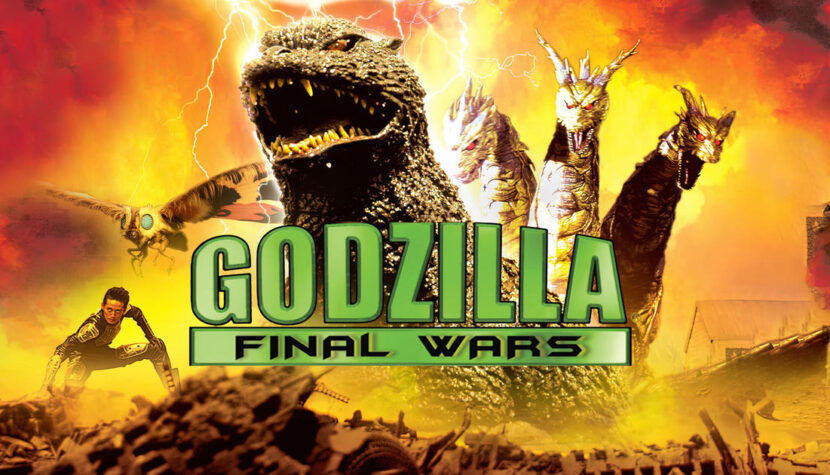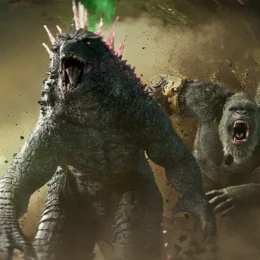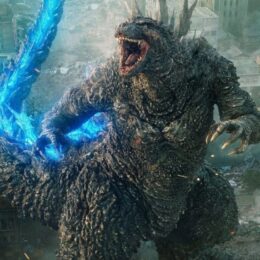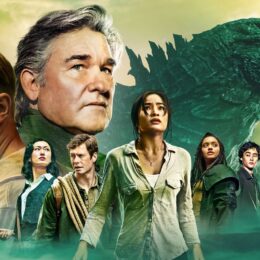GODZILLA: FINAL WARS. The very beginning of this movie is dizzying

When I was a child, when every medium-sized village had a cinema, and Saturday mornings and afternoons were spent there, the most excitement was always stirred by the frequently appearing life-demolishing monster called Godzilla. I watched his adventures with clenched fists and wide-eyed amazement along with a bunch of kids like myself. With age, the enthusiasm and love for Japan’s export mascot diminished, but I never denied the affection for the, still somewhat endearing, lizard. I followed Godzilla’s endeavors quite meticulously, observed how his family grew, and the number of productions with his involvement increased. I watched them all, although they no longer amused me as they did before. Some moves by the producers in the newer episodes of the series evoked mixed feelings in me. However, the announcements from the legendary Toho studio about the production of another installment, this time for the 50th anniversary, revived hope in me. Soon, the premiere of the 28th episode became a reality.
At the end of 2004, the premieres of Godzilla were shown for the first time, first in the United States, and shortly after in Japan. The marketing campaign, on a larger scale than usual, worked. Older dormant fans woke up, while younger ones wondered how the marriage with the past would look like. As it turned out, the Japanese, fortunately, are not familiar with the Polish saying: “It was supposed to be so beautiful, but it turned out as usual,” and they made a film that met expectations, reconciling younger and older generations, providing entertainment for true Godzilla-ultras.

There was no screenplay revolution. And it couldn’t be. What has delighted the eye for half a century in the flagship film could not be a novelty. So, as usual, it is electrifying and explosive, though somewhat stereotypical. In the early 21st century, destructive monsters emerge simultaneously in ten metropolises around the world, sowing fear and terror among the inhabitants. Cities like Sydney, Paris, New York, Saigon, or Tokyo experience catastrophes on the scale of Hurricane Katrina. Even before the reaction of Earth Defense Forces, the perpetrators of the whole chaos disappear, teleported by mysterious flying objects, which, as it turns out, belong to extraterrestrial beings calling themselves Xiliams (from the name of planet X). They propose a peace treaty, over which some Earthlings ponder, while a small group of determined desperados (biologist Miyuki Otonashi, brave and incredibly strong mutant Shin’ichi Ôzaki along with Captain Douglas Gordon) take on an uneven fight against the overwhelming enemy forces. Uneven? Hmm, maybe not entirely, because they come up with a brilliant plan – thaw Godzilla from the Arctic ice, who, despite his unfriendly attitude towards humans, considers those hideous creatures from outer space as his greatest enemies. The fight for freedom begins!
As you can see, Messrs. Isao Kiriyama and Ryuhei Kitamura didn’t strain themselves too much, probably writing the script in one evening over beers, but adding a taste of jubilee to the whole. Nevertheless, the film is a real feast for Godzilla enthusiasts, full of allusions and treats. The very beginning is dizzying; in the opening credits, the editors treat us to the history of the series, in a huge summary presenting the most interesting shots from most Godzilla movies, emphasizing the physical development (less psychological) of this rubber creature. The biggest attraction of the film is undoubtedly the gathering of so many Godzilla opponents in one movie. Such a cast is hard to find in previous pictures. Not only that, some of them returned to the favor of Toho producers after a 30-year hiatus. Despite their pre-retirement age, they performed excellently in destruction and demolition: Gigan (not seen since 1973), Angilas (since 1974), Kumonga, Manda, Rodan, Kamakaris, Ebirah, King Shisa, Hedorah, and of course, King Ghidorah (here appeared as Kaiser-Ghidorah). I only missed Mechagodzilla, but unfortunately, you can’t have everything. As a consolation, he appeared quite regularly in previous installments. In a word, a team of real connoisseurs and tough guys.
Related:
On the bright side, apart from the titular powerhouse, the well-deserved warrior Mothra stood, doing everything to stop the onslaught of evil and hatred. The cast is complemented by Godzilla’s son, Minya, who, due to his young age and small stature, does not get involved in adult matters, cheering for his robust dad, of course. Another noteworthy feat, also a tasty morsel for Godzilla enthusiasts, is the appearance in one of the roles of Akira Takarada, who played as a nineteen-year-old in the first film of the series in 1954. Interestingly, despite the poorly received American version of Godzilla from 1998 directed by Roland Emmerich, the Japanese decided to include the creature created then in Godzilla: Final Wars, calling it Zilla. He is the only one entirely generated by a computer and, of course, has zero chances in a confrontation with the only correct image of Godzilla, which can be read (if one insists on fabricating ideology) unequivocally – hands off our national hero.

The film, besides its jubilee attributes, is a spectacle that has a really decent visual setting, combining elements of modern cinema with shots, dynamic editing, and special effects reminiscent of The Matrix or Minority Report (this applies to scenes with people, especially well-executed duels) and the classic school, based on cardboard buildings, miniatures, and sometimes stop-motion animation (monster duels). This creates a fantastic effect when enjoying the film, giving the impression of continuous time travel. This technique will surely satisfy the most discerning fans of the series (and not only). And what else? Of course, above all, insane, unpredictable battles of giants in various configurations: one-on-one, two-on-one, or even four-on-one. I must reassure the enthusiasts – there is nothing to fear; Godzilla, despite a few weaker actions and catching a few unexpected blows, is unbeatable and eliminates his rivals with the cold blood of a professional killer. And that towers, landmarks, or the Sydney Opera suffer as usual, not to mention cars and people, well, such is fate. No one else and nowhere else is able to provide such destruction in contemporary cinematography. The unique poetic kitschiness will put the most fervent opponents of this type of film attraction in a joyful and almost fanatical mood. It’s worth mentioning the acting. Tsutomu Kitagawa once again flawlessly embodied the role of Godzilla donning the historical rubber suit. It’s amazing that in such conditions, he can still draw out those immense talents. As you can see, the old school of acting is still in vogue, and the Japanese, despite technological progress, still adhere to tradition.
However, Ryuhei Kitamura did not avoid a few flaws, which may not be heinous neglect, but sometimes spoil the fun. A significant downside is the too late entry of the titular killer – only after an hour, which is unforgivable in a two-hour film, and the result is too much accumulation of attractions in the second part of the picture. How else to explain the situation where we have simultaneously four duels taking place? And the problem that has always plagued the creators of this series – the lack of distance and humor. Fans as well as casual viewers treat these productions with a wink, and it seems that the authors should have the same approach. Perhaps it is the fault of the Japanese mentality, but personally, I miss that in such a film (can anyone shed a tear over the fate of the unfortunate monster that is a cross between a rabbit and a dog?). Fortunately, minor shortcomings are not able to spoil the joy that comes from dealing with this monumental work, with an ending reminiscent of classic westerns, with lawmen and guardians of justice… that is, law and morality, to be precise. In conclusion, I will only mention that it is worth listening to the music composed by one of the members of the classic American band “Emerson, Lake & Palmer,” Keith Emerson, as well as the cheerful neopunks from Sum 41. I can only wish for such a cultural giant to emerge in Poland one day. Unfortunately, the recently established Institute of Film Art probably won’t allow that. I’ll have to take matters into my own hands…




